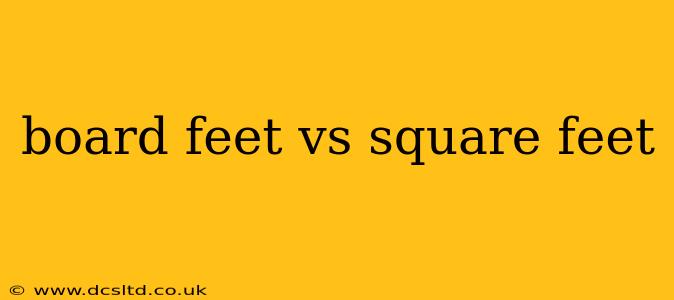Understanding the difference between board feet and square feet is crucial, especially when working with lumber. While both measure area, they do so in vastly different contexts, leading to confusion for many. This comprehensive guide will clarify the distinction, highlighting practical applications and helping you confidently navigate lumber calculations.
What is a Square Foot?
A square foot (sq ft) is a unit of area measurement, representing a square with sides measuring one foot in length. It's a common unit used for measuring floor space, wall area, and other two-dimensional surfaces. Calculating square footage is straightforward: you simply multiply length by width (Length x Width = Square Footage). For example, a room 10 feet long and 12 feet wide has an area of 120 square feet (10 ft x 12 ft = 120 sq ft).
What is a Board Foot?
A board foot (bd ft) is a unit of volume used specifically for lumber. It represents a piece of wood measuring 1 foot long, 1 foot wide, and 1 inch thick. Unlike square footage, which only considers the surface area, board feet account for the thickness of the wood, making it a more accurate measure for the amount of wood contained in a piece.
Calculating Board Feet: The formula for calculating board feet is:
(Thickness in inches x Width in feet x Length in feet) / 12 = Board Feet
For example, a board that's 1 inch thick, 6 inches wide (0.5 feet), and 8 feet long would contain 4 board feet: (1 x 0.5 x 8) / 12 = 4 bd ft.
Why Use Board Feet Instead of Square Feet for Lumber?
Using board feet instead of square feet for lumber is essential because it accounts for the volume of wood. A large, thin piece of wood might have a significant square footage but contain less actual wood than a smaller, thicker piece. Board feet provide a standardized measure of the amount of lumber, regardless of its dimensions. This is especially critical when purchasing lumber, as pricing is often based on board feet.
How Are Board Feet Used in the Lumber Industry?
Board feet are the standard unit of measurement used by lumberyards and contractors to determine the cost and quantity of lumber needed for a project. It allows for accurate estimations of material costs and ensures consistency in pricing across different lumber sizes.
What is the difference between board feet and linear feet?
While board feet measure volume, linear feet measure length. Linear feet simply measure the length of a board in feet, disregarding its width and thickness. It’s important not to confuse these two measurements as they are used for entirely different purposes. Linear feet are useful for estimating the length of trim or other materials, while board feet are used when the volume of wood is a critical factor.
How do I convert square feet to board feet?
You cannot directly convert square feet to board feet without knowing the thickness of the lumber. Square feet only represent surface area, while board feet represent volume. To convert, you need the thickness of the wood in inches and then apply the board foot formula.
How do I calculate board feet for lumber with unusual dimensions?
For lumber with unusual dimensions or multiple pieces, break down the calculation into smaller, manageable sections using the board foot formula for each piece, then add the results to obtain the total board feet.
What are some common applications of board feet calculations?
Board feet calculations are crucial for various applications, including:
- Estimating lumber costs for construction projects: Accurately determining the amount of lumber needed for framing, flooring, or other structural elements.
- Pricing lumber: Lumberyards use board feet to price lumber fairly, reflecting the amount of wood in each piece.
- Inventory management: Tracking lumber inventory using board feet ensures accurate stock levels.
- Project planning: Knowing the required board feet ensures you purchase sufficient lumber for a project without waste.
Understanding the difference between board feet and square feet is vital for anyone working with lumber. Using the correct measurement ensures accurate estimations, efficient purchasing, and prevents costly mistakes. By applying the appropriate formulas and understanding the underlying concepts, you can confidently tackle your lumber projects.
